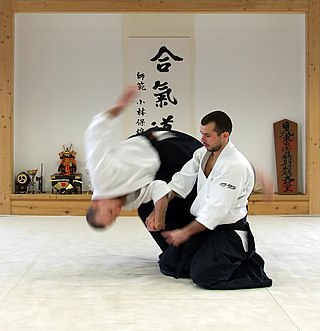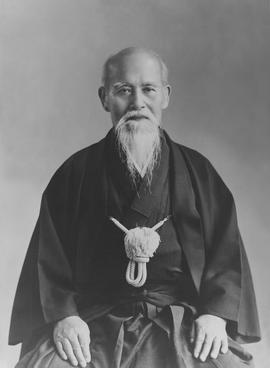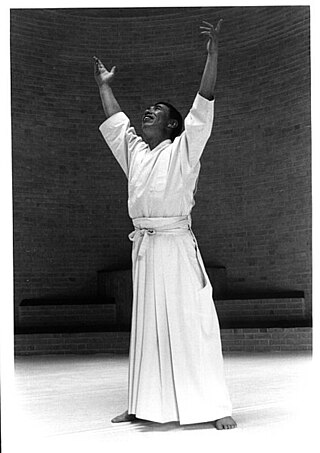
Aikido is a modern Japanese martial art that is split into many different styles, including Iwama Ryu, Iwama Shin Shin Aiki Shuren Kai, Shodokan Aikido, Yoshinkan, Renshinkai, Aikikai and Ki Aikido. Aikido is now practiced in around 140 countries. It was originally developed by Morihei Ueshiba, as a synthesis of his martial studies, philosophy and religious beliefs. Ueshiba's goal was to create an art that practitioners could use to defend themselves while also protecting their attackers from injury. Aikido is often translated as "the way of unifying (with) life energy" or as "the way of harmonious spirit". According to the founder's philosophy, the primary goal in the practice of aikido is to overcome oneself instead of cultivating violence or aggressiveness. Morihei Ueshiba used the phrase masakatsu agatsu katsuhayabi" to refer to this principle.

Morihei Ueshiba was a Japanese martial artist and founder of the martial art of aikido. He is often referred to as "the founder" Kaiso (開祖) or Ōsensei (大先生/翁先生), "Great Teacher".

The Aikikai is the original school of Aikido. It is centered on the Aikikai Foundation in Japan, and its figurehead is the Doshu. It is represented globally through the International Aikido Federation.
Morihiro Saito was a teacher of the Japanese martial art of aikido, with many students around the world. Saito's practice of aikido spanned 56 years, from the age of 18, when he first met aikido founder Morihei Ueshiba, until his death in 2002.
Iwama-style Aikido(岩間合気道) is the style of aikido that was taught in Iwama by the founder of aikido, Morihei Ueshiba, and especially the lineage passed on through Morihiro Saito, a close disciple who was given responsibility over Iwama dojo by Ueshiba.
The Iwama Dōjō is a dōjō built by the founder of aikido, Morihei Ueshiba, who lived there from 1942 until his death in 1969. It is located in the former town of Iwama and became an important historical location for the development of aikido and "a Mecca to the aikido community." This dojo is also where Morihiro Saito, one of the founder's closest students, learned and taught aikido from 1946 until 2002 developing what is often referred to as the Iwama Style.

Koichi Tohei was a 10th Dan aikidoka and founder of the Ki Society and its style of aikido, officially Shin Shin Toitsu Aikido, but commonly known as Ki-Aikido.

Michio Hikitsuchi was an aikido instructor and was the chief instructor of the Kumano Juku Dojo, in Shingu, Wakayama Prefecture, Japan, for fifty years.

Shoji Nishio was a Japanese aikido teacher holding the rank of 8th dan shihan from the Aikikai. He was a direct student of Aikido founder Morihei Ueshiba, practiced along with Seigo Yamaguchi and Hiroshi Tada. He also achieved multiple high ranking honors in other martial arts, of which the most notable are Iaido, Judo, Karate.
Shin Shin Toitsu Aikido (心身統一合氣道) or Ki Aikido is a Japanese martial art, a gendai budo . It is part of the martial arts derived from aikido, which appeared after its founder's death in 1969. It started in early 70's with the creation of the Ki Society of Koichi Tohei, the previous Aikikai's Chief Instructor. This martial art focuses on mind and body coordination and is based on aikido techniques and Japanese yoga and promote non-violent conflict solving and self-development.

Masamichi Noro is the founder of Kinomichi and was an uchi-deshi of Morihei Ueshiba, the founder of Aikido.
Seiseki Abe was a Japanese shodo and aikido teacher who had a unique relationship with aikido founder Morihei Ueshiba, being both his student in aikido and his teacher in calligraphy.
Bansen Tanaka was a Japanese aikido master and a pre-war and post-war disciple of aikido founder Morihei Ueshiba.

The Aikido Schools of Ueshiba (ASU) is a not-for-profit Aikido organization founded by Mitsugi Saotome Shihan upon moving from Japan to the United States in 1975. It is a federation of about 110 Dojos throughout North America.

Hirokazu Kobayashi was a Japanese aikido teacher and student of the founder of aikido Morihei Ueshiba. In 1970, at the age of 41, he was awarded 8th dan rank. He is the initiator of Kobayashi aikido (国際合気道研修会小林裕和派).
William Gleason is the American author of two books about aikido, spirituality and kototama. He holds the rank of 7th dan in aikido and is the founder and head instructor of Shobu Aikido in Somerville, MA, USA. Gleason teaches seminars worldwide.
Tsutomu Yukawa was a Japanese aikidoka.
Alan Ruddock was an Irish Martial Arts pioneer, teacher and writer. He introduced both Aikido & Karate to Ireland and was the founder of the Aiki no Michi and its interpretation of Aikido. Ruddock was one of the few western Aikido practitioners and only Irish national who studied directly under the founder of Aikido, Morihei Ueshiba ("O-Sensei").

Stanley A. Pranin was an American martial artist, founding publisher, and editor-in-chief of Aikido Journal. Pranin, a researcher and archivist of aikido, has written and published several books and many articles about aikido, Daito-ryu Aikijujutsu, and Morihei Ueshiba and was an influential figure in the aikido world.

Shihan Haruo Matsuoka. Born in Osaka, Matsuoka was first introduced to martial arts through judo as part of his required physical education curriculum in high school. His father, Shiro Matsuoka, then enrolled Haruo in a summer camp where he would witness his first aikido demonstration.












